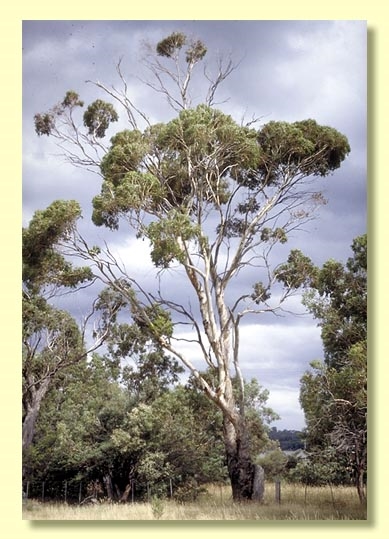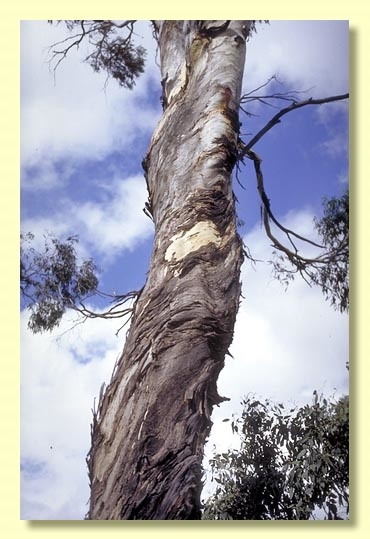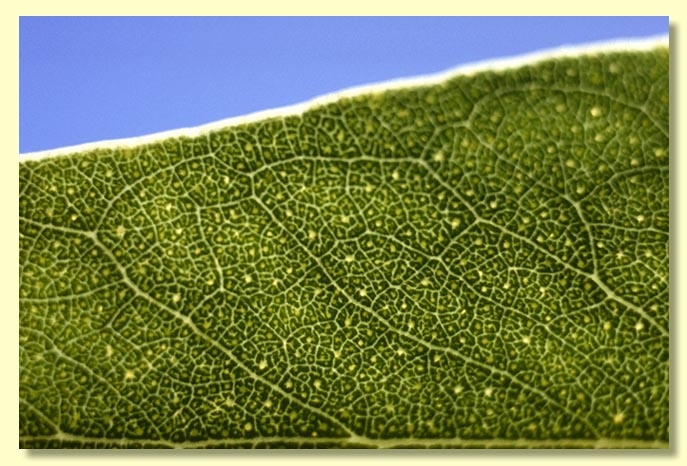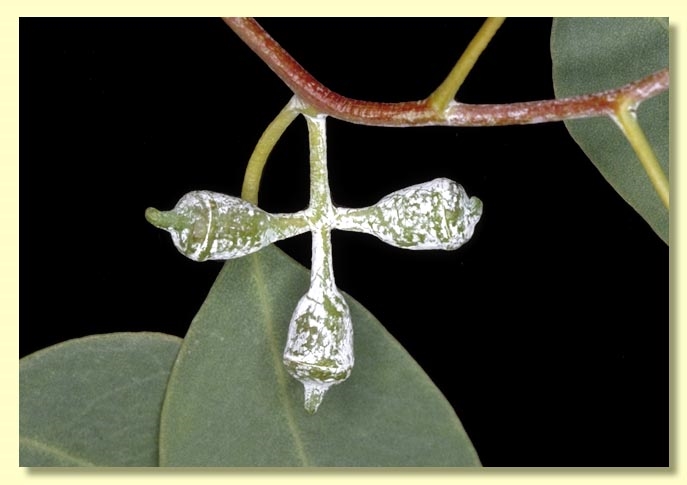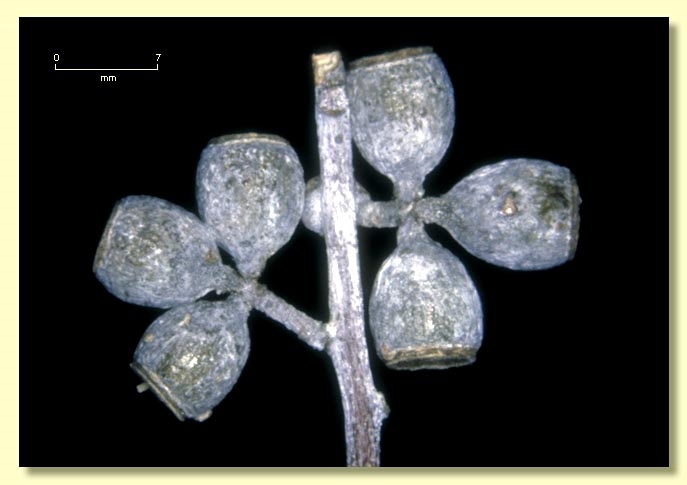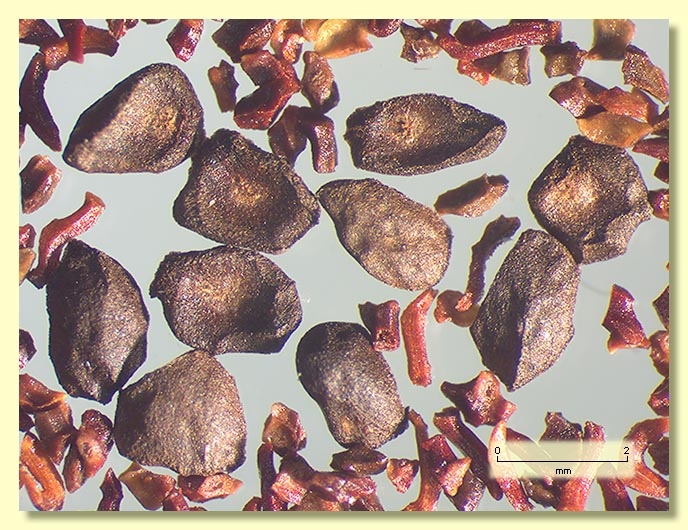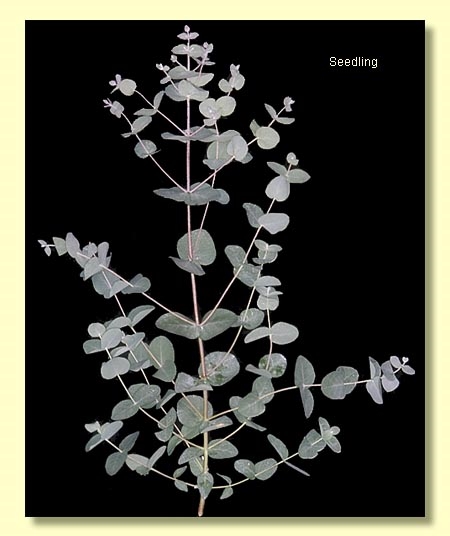Euclid - Online edition
Eucalyptus morrisbyi
Eucalyptus | Symphyomyrtus | Maidenaria | Euryotae | Orbiculares
T: 'junction of the South Arm and Clifton Beach roads', Tas., collector not designated; syn: HO.
Tree to 16 m tall. Forming a lignotuber.
Bark loose grey-black basal slabs for 1–2 m of trunk then smooth, pale grey, yellowish and pale coppery above; branchlets glaucous.
Juvenile growth (coppice or field seedlings to 50 cm): stem rounded in cross-section, glaucous, warty; juvenile leaves opposite and sessile for many pairs, orbicular, 1–4.5 cm long, 1–3.5 cm wide, margin usually crenulate, base lobed, usually glaucous.
Adult leaves alternate, petiole 0.9–2.5 cm long; blade lanceolate to ovate or elliptical, 4.7–10 cm long, 1.5–4 cm wide, often undulate, base tapering to petiole, concolorous, dull, blue-green to green or glaucous, side-veins greater than 45° to midrib, densely reticulate, intramarginal vein parallel to and just within margin or well removed from it and looped, oil glands island and intersectional.
Inflorescence axillary unbranched, peduncles 0.4–1 cm long, buds 3 per umbel, sessile or pedicellate, pedicels 0–0.5 cm long. Mature buds pyriform to oblong to obovoid, 0.7–0.8 cm, long, 0.5–0.6 cm wide, glaucous or green, scar present, operculum conical to beaked, stamens inflexed, anthers cuboid to oblong, versatile, dorsifixed, dehiscing by longitudinal slits (non-confluent), style long, stigma blunt, locules 3 or 4, the placentae each with 4 vertical ovule rows or sometimes 5 or 6 rows. Flowers white.
Fruit sessile or on pedicels to 0.3 cm long, barrel-shaped or cylindrical, 0.6–0.9 cm long, 0.7–0.8 cm wide, glaucous, disc descending, valves 3 or 4, enclosed.
Seeds dark grey, black or brown, 1–2.5 mm long, ovoid or flattened-ovoid, often lacunose, dorsal surface shallowly pitted, hilum ventral.
Cultivated seedlings (measured at ca node 10): cotyledons more or less oblong; stems rounded in cross-section, glaucous, warty; leaves opposite for many nodes, sessile, cordate to orbicular, 1.5–4.5 cm long, 1.5–3.5 cm wide, base amplexicaul, margin crenulate or entire, apex rounded, usually glaucous.
Flowering has been recorded in all months except September but with peak flowering January to April (see Williams & Potts, 1996, p. 78)
Eucalyptus morrisbyi is popular in cultivation as a specimen tree and in windbreaks.
A small to medium-sized tree of very restricted distribution in south-eastern Tasmania in the Geilston Bay and South Arm areas.
E. morrisbyi is one of several three-budded species in Tasmania, differing by its cupular to cylindrical fruit from E. viminalis, E. dalrympleana and E. rubida, which have obconical to hemispherical fruit; from E. urnigera, which has urceolate fruit; from E. cordata by the crown of adult leaves; and from E. gunnii and E. archeri by the more distinct pedicels of the buds and fruit and its strictly coastal occurrence.
Eucalyptus morrisbyi belongs in Eucalyptus subgenus Symphyomyrtus section Maidenaria, a large group of species more or less restricted to south-eastern Australia, characterised by bilobed cotyledons, simple axillary inflorescences, buds with two opercula, stamens with versatile anthers and flattened seeds with a ventral hilum. Within this section, E. morrisbyi, with nine other species, forms series Orbiculares having orbicular juvenile leaves opposite for many nodes, a grey-green to glaucous crown, and buds in threes. Series Orbiculares is confined to far south-eastern New South Wales, eastern Victoria and Tasmania.
Eucalyptus morrisbyi is listed as "Endangered" under the Australian Government Environment Protection and Biodiversity Conservation Act 1999 (EPBC Act). Further information may be found at this web address:
http://www.environment.gov.au/cgi-bin/sprat/public/sprat.pl

